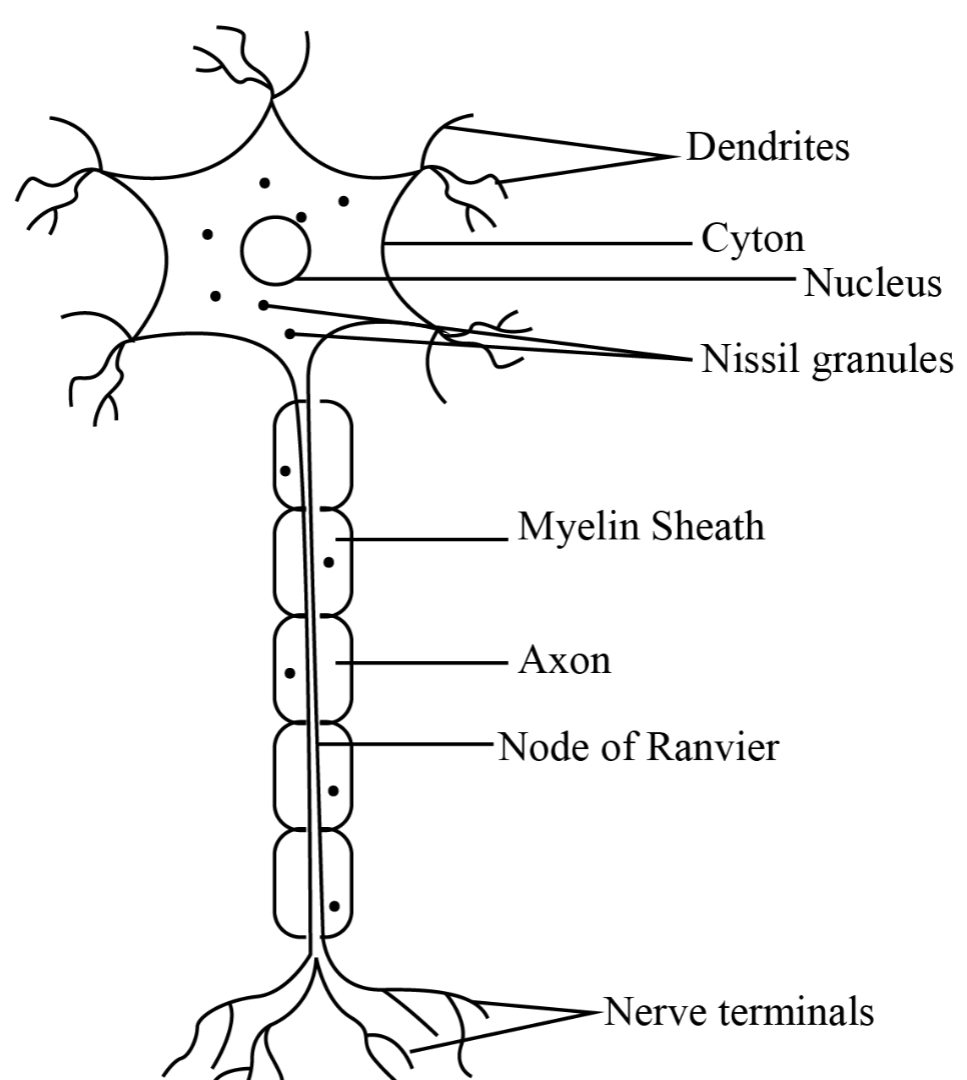
Make a sketch of the human nerve cell. What function does the nerve cells perform?
Answer
557.1k+ views
Hint: Human nervous system is a very complex system. It is a part of the body that organizes its behavior and transfers signals to the body organs. In vertebrates, it contains two main types of the nervous system that are central nervous system (CNS) and peripheral nervous system (PNS).
Complete Answer:

The anatomy of neurons consists of:
(I) Cell body
(II) Dendrites
(III) Axon
(IV) Myelin sheath cells
(V) Nodes of Ranvier
(VI) Axon terminal bundle
We know that our whole body involves a huge amount of neurons or nerve cells and every part of the body is connected with these nerves and plays a vital role in the body's functioning. Nerve cells are also called neurons which are very important components or active components of our nervous system. They can communicate with each other as well as to other cells by electrical and chemical signals (nerve impulses). These signals in turn allow the effector organs to respond towards the appropriate stimuli. Neurons/nerve cells are the individual specific cell structure that is firstly involved in the process of information transmission. Neurons/nerve cells are found in the brain, spinal cord, and peripheral nervous system, it is a structural and functional unit of the nervous system.
Here it is described the three major functions of human nerve cells:
- Nerve cells are present in our brain, spinal cord, and peripheral nerves. Nerve cells transmit the information to the brain from different organs and vice versa. It has full control over all body functioning.
- Neurons are the basic unit of the nervous system. It has been carrying nerve signals from the brain to different organs and transmits the messages to the overall body.
- It is dedicated to carrying messages or information while the endocrine system delivers chemical integration by secreting hormones.
Note: Our nervous system is two types of the central and peripheral nervous system. Neurons or nerve cells are the active components of the nervous system. It majorly works as a signal molecule and transfers information from the brain to the other effector organs.
Complete Answer:

The anatomy of neurons consists of:
(I) Cell body
(II) Dendrites
(III) Axon
(IV) Myelin sheath cells
(V) Nodes of Ranvier
(VI) Axon terminal bundle
We know that our whole body involves a huge amount of neurons or nerve cells and every part of the body is connected with these nerves and plays a vital role in the body's functioning. Nerve cells are also called neurons which are very important components or active components of our nervous system. They can communicate with each other as well as to other cells by electrical and chemical signals (nerve impulses). These signals in turn allow the effector organs to respond towards the appropriate stimuli. Neurons/nerve cells are the individual specific cell structure that is firstly involved in the process of information transmission. Neurons/nerve cells are found in the brain, spinal cord, and peripheral nervous system, it is a structural and functional unit of the nervous system.
Here it is described the three major functions of human nerve cells:
- Nerve cells are present in our brain, spinal cord, and peripheral nerves. Nerve cells transmit the information to the brain from different organs and vice versa. It has full control over all body functioning.
- Neurons are the basic unit of the nervous system. It has been carrying nerve signals from the brain to different organs and transmits the messages to the overall body.
- It is dedicated to carrying messages or information while the endocrine system delivers chemical integration by secreting hormones.
Note: Our nervous system is two types of the central and peripheral nervous system. Neurons or nerve cells are the active components of the nervous system. It majorly works as a signal molecule and transfers information from the brain to the other effector organs.
Recently Updated Pages
Master Class 10 Computer Science: Engaging Questions & Answers for Success

Master Class 10 General Knowledge: Engaging Questions & Answers for Success

Master Class 10 English: Engaging Questions & Answers for Success

Master Class 10 Social Science: Engaging Questions & Answers for Success

Master Class 10 Maths: Engaging Questions & Answers for Success

Master Class 10 Science: Engaging Questions & Answers for Success

Trending doubts
The shortest day of the year in India

Why is there a time difference of about 5 hours between class 10 social science CBSE

Write a letter to the principal requesting him to grant class 10 english CBSE

What is the median of the first 10 natural numbers class 10 maths CBSE

The Equation xxx + 2 is Satisfied when x is Equal to Class 10 Maths

State and prove converse of BPT Basic Proportionality class 10 maths CBSE




